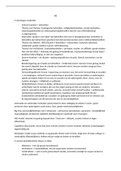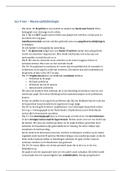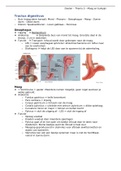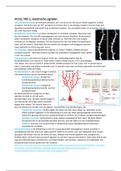lOMoARcPSD|440 687 0
Introducing Sociolinguistics- Chapters 6-11
summary
Utrecht University
, lOMoARcPSD|440 687 0
Chapter 6: Multilingualism and language choice
Introduction
Vitality: demographic, social and institutional strength of a language and its speakers
- Likelihood that a language will continue being used for a range of social functions by a
community of speakers. It is influenced by institutional, social and demographic factors
Diglossia: classically defined as a situation where two closely related languages are used in a
speech community. One for high (H) functions (e.g. church, newspapers) and one for low (L)
functions (e.g. home or at the market). The situation is supposed to be relatively stable and the
languages/varieties remain distinct. Now often extended to refer to any two languages (even
typologically unrelated ones) that have his kind of social and functional distribution.
Language policy and language planning in multilingual societies
Invisible language: a language variety that, because of its social stigma, isn’t written down
becomes invisible to contemporary speakers/signers and future readers/signers
- Blocked or omitted from written or formal discourse. Many signed languages around the
world suffer chronic invisibility: they are both synchronically and diachronically invisible.
Implied language policy: the unspoken attitudes people hold about languages, where they
should be used, by who and for what purposes. The practice that give substance to those
attitudes.
Overt language policy: principles guiding the use and recognition of language in formal,
institutional or national context
Language rights in South Africa’s constitution
National language: a linguistic variety that has been chosen by a nation as the language
expressing or representing national identity
Official language: a linguistic variety that has been designated as the medium for all official,
government business. There is usually a right to have all legal and public services provided in
an official language, and an obligation on state or regional authorities to satisfy this right.
Ethnolinguistic vitality
Ethnolinguistic vitality: a measure of the strength and liveliness of a language, usually a good
indicator of the likelihood that it will gradually die out or continue to be used as the living
language of a community. Measured in terms of demographic, social and institutional support.
- High vitality: spoken and used widely.
- If the speakers of a language have higher social status within the larger community, the
ethnolinguistic vitality of that variety will be higher too. This is also the reason that Latin
is still used today, speakers of that language have a high status.
, lOMoARcPSD|440 687 0
- Widespread use of the language in mass media, as the medium of education and in
official government business all increase the vitality of a language. More local and
home-based activities, such as maintenance of a language for religious purposes and for
regular cultural events, mean that even if the language is not widely used for daily
conversation, it can retain a degree of vitality; this will also favour its long-term
maintenance.
- A language might have relatively little social and economic status, and little institutional
support, but if the group of people speaking the language appreciably outnumber the
speaker of other languages, and particularly if they are relatively concentrated in as
specific area, than the long-term prognosis for the maintenance of that language is
improved.
Diglossia in a community
Diglossia: two languages with distinct functional roles in one community
Is ‘vitality’ the same as ‘prestige’?
Probably if a language ranks highly in terms of institutional measures of vitality, it will always
have a degree of overt prestige associated with it. The notion of ethnolinguistic vitality has some
advantages over prestige. IT gets away from any confusion or indeterminacy surrounding terms
like prestige, because it avoids the need to make a distinction between norms that people are
consciously orienting to (overt prestige) and those that they seem to be less consciously
orienting to (convert prestige).
Code switching and code mixing
Code switching: in its most specific sense, the alternation between varieties, or codes, across
sentences or clause boundaries. Often used as a cover term including code mixing as well.
- Phenomenon of moving between distinct varieties
Domain: the social and physical setting in which speakers find themselves
Introducing Sociolinguistics- Chapters 6-11
summary
Utrecht University
, lOMoARcPSD|440 687 0
Chapter 6: Multilingualism and language choice
Introduction
Vitality: demographic, social and institutional strength of a language and its speakers
- Likelihood that a language will continue being used for a range of social functions by a
community of speakers. It is influenced by institutional, social and demographic factors
Diglossia: classically defined as a situation where two closely related languages are used in a
speech community. One for high (H) functions (e.g. church, newspapers) and one for low (L)
functions (e.g. home or at the market). The situation is supposed to be relatively stable and the
languages/varieties remain distinct. Now often extended to refer to any two languages (even
typologically unrelated ones) that have his kind of social and functional distribution.
Language policy and language planning in multilingual societies
Invisible language: a language variety that, because of its social stigma, isn’t written down
becomes invisible to contemporary speakers/signers and future readers/signers
- Blocked or omitted from written or formal discourse. Many signed languages around the
world suffer chronic invisibility: they are both synchronically and diachronically invisible.
Implied language policy: the unspoken attitudes people hold about languages, where they
should be used, by who and for what purposes. The practice that give substance to those
attitudes.
Overt language policy: principles guiding the use and recognition of language in formal,
institutional or national context
Language rights in South Africa’s constitution
National language: a linguistic variety that has been chosen by a nation as the language
expressing or representing national identity
Official language: a linguistic variety that has been designated as the medium for all official,
government business. There is usually a right to have all legal and public services provided in
an official language, and an obligation on state or regional authorities to satisfy this right.
Ethnolinguistic vitality
Ethnolinguistic vitality: a measure of the strength and liveliness of a language, usually a good
indicator of the likelihood that it will gradually die out or continue to be used as the living
language of a community. Measured in terms of demographic, social and institutional support.
- High vitality: spoken and used widely.
- If the speakers of a language have higher social status within the larger community, the
ethnolinguistic vitality of that variety will be higher too. This is also the reason that Latin
is still used today, speakers of that language have a high status.
, lOMoARcPSD|440 687 0
- Widespread use of the language in mass media, as the medium of education and in
official government business all increase the vitality of a language. More local and
home-based activities, such as maintenance of a language for religious purposes and for
regular cultural events, mean that even if the language is not widely used for daily
conversation, it can retain a degree of vitality; this will also favour its long-term
maintenance.
- A language might have relatively little social and economic status, and little institutional
support, but if the group of people speaking the language appreciably outnumber the
speaker of other languages, and particularly if they are relatively concentrated in as
specific area, than the long-term prognosis for the maintenance of that language is
improved.
Diglossia in a community
Diglossia: two languages with distinct functional roles in one community
Is ‘vitality’ the same as ‘prestige’?
Probably if a language ranks highly in terms of institutional measures of vitality, it will always
have a degree of overt prestige associated with it. The notion of ethnolinguistic vitality has some
advantages over prestige. IT gets away from any confusion or indeterminacy surrounding terms
like prestige, because it avoids the need to make a distinction between norms that people are
consciously orienting to (overt prestige) and those that they seem to be less consciously
orienting to (convert prestige).
Code switching and code mixing
Code switching: in its most specific sense, the alternation between varieties, or codes, across
sentences or clause boundaries. Often used as a cover term including code mixing as well.
- Phenomenon of moving between distinct varieties
Domain: the social and physical setting in which speakers find themselves










